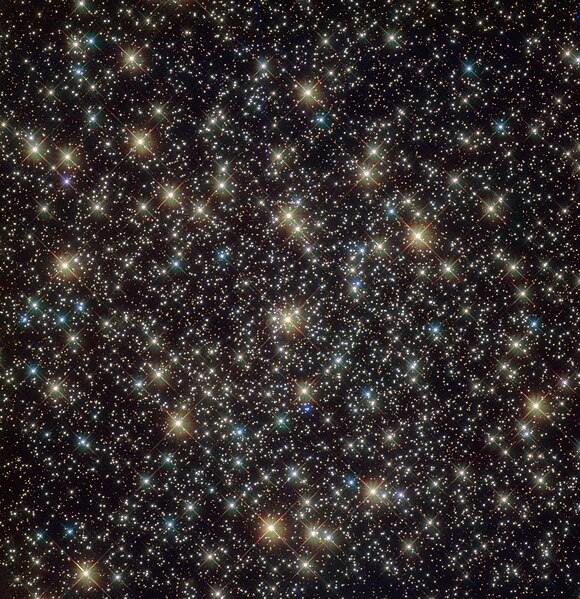File:Caldwell 79.jpg

原始文件 (3,007 × 3,106像素,文件大小:4.07 MB,MIME类型:image/jpeg)
摘要
| 描述Caldwell 79.jpg |
English: This Hubble image features stars at the center of the glittering globular cluster Caldwell 79. Globular clusters are dense, gravitationally bound packs of stars that roam the fringes of the galaxy. Most of the Milky Way’s globular clusters are estimated to be over 10 billion years old — about twice as old as our solar system. They typically contain hundreds of thousands of stars that are thought to have formed at roughly the same time. They also contain some of the most ancient stars in our galaxy, but their role in galactic evolution is still a matter of study.
This image combines visible and ultraviolet observations taken with two of Hubble’s cameras: the Advanced Camera for Surveys and the Wide Field Camera 3. Hubble targeted Caldwell 79 because it has some peculiar qualities that could help astronomers understand how globular clusters form and evolve. The cluster harbors a dark secret in its core — a black hole that’s indirectly visible through its gravitational effects on a nearby star. The cluster’s orbit is also puzzling because Caldwell 79 whips around the center of the galaxy in the opposite direction than what we would expect. This may indicate that Caldwell 79 didn’t originate in our galaxy at all — it may have formed elsewhere and then been ensnared by the Milky Way’s gravity when the cluster passed close by. Possibly countering the theory that Caldwell 79 is of extragalactic origin, the cluster is chemically very similar to the galaxy’s other globular clusters. Further observations may reveal whether the cluster originated in our galaxy or formed elsewhere to be later subsumed. Caldwell 79 was discovered by Scottish astronomer James Dunlop in 1826 and is also cataloged as NGC 3201. The cluster is located relatively nearby — about 16,000 light-years away toward the Vela constellation. With a magnitude of 6.7, it’s just a bit too dim to be seen with the unaided eye. A pair of binoculars is sufficient to view the cluster, though it will be a much more impressive spectacle viewed through a telescope. Unfortunately, Caldwell 79 isn’t easily visible from most northern latitudes, except those close to the equator, where observers can look for it in the springtime. The cluster is best viewed from the Southern Hemisphere during autumn months. For more information about Hubble’s observations of Caldwell 79, see: www.nasa.gov/image-feature/goddard/2018/hubbles-standout-... Credit: ESA/Hubble & NASA, Acknowledgement: Sarajedini et al For Hubble's Caldwell catalog site and information on how to find these objects in the night sky, visit: www.nasa.gov/content/goddard/hubble-s-caldwell-catalog |
| 日期 | |
| 来源 | https://www.flickr.com/photos/144614754@N02/49213185718/ |
| 作者 | NASA Hubble |
许可协议
| 这幅图片原始出处为Flickr的https://flickr.com/photos/144614754@N02/49213185718 ,作者为NASA Hubble 。经机器人FlickreviewR 2在2020年2月23日审查后确定为采用cc-by-2.0的协议授权使用。 |
2020年2月23日
说明
22 1 2018
image/jpeg
4,263,245 字节
3,106 像素
3,007 像素
文件历史
点击某个日期/时间查看对应时刻的文件。
| 日期/时间 | 缩略图 | 大小 | 用户 | 备注 | |
|---|---|---|---|---|---|
| 当前 | 2020年2月23日 (日) 20:03 |  | 3,007 × 3,106(4.07 MB) | Killarnee | User created page with UploadWizard |
文件用途
以下页面使用本文件:
全域文件用途
以下其他wiki使用此文件:
元数据
此文件中包含有扩展的信息。这些信息可能是由数码相机或扫描仪在创建或数字化过程中所添加。
如果此文件的源文件已经被修改,一些信息在修改后的文件中将不能完全反映出来。
| 提供人 | ESA/Hubble & NASA |
|---|---|
| 来源 | ESA/Hubble |
| 简称 |
|
| 图像标题 |
|
| 使用条款 |
|
| 数据生成日期时间 | 2018年1月22日 (一) 06:00 |
| 关键词 | NGC 3201 |
| 联系信息 |
-{R|http://www.spacetelescope.org}- Karl-Schwarzschild-Strasse 2 Garching bei München, , D-85748 Germany |
| IIM 版本 | 4 |

